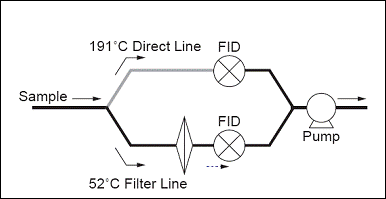


|
Industry Solutions |
|
The goal of this method is to allow for real-time measurement. With the flame ionization detection (FID) method, the exhaust gas is burned by a hydrogen flame and the particulate matter (PM) concentration is calculated based on the ion current that develops during the burning. This method can continuously measure soot and soluble organic fraction (SOF) independently. In the figure below it shows the flow of gas used with this method as well as the signal outputs by the detectors during the engine exhaust measurement. Basically the exhaust gas flow is split into two lines, one at 191°C, and one with the temperature adjusted to 52°C. In the 52°C line, the solid components in the gas are removed by a filter, so only the gaseous components are fed to the FID. While the 191°C line, the gas is fed directly to the FID. |
|
Idea #1:Flame Ionization Detection Method |

|
The output from the 191°C line includes a pulse signal. The signal is caused by carbon particles, and is proportional to the soot concentration. The difference in the amount of vaporized hydrocarbons under each condition correlates to the SOF concentration. Using both the filter weighing method and the FID method, measurements are made for various types of engines, and the measurement results used to calibrate the mass concentration scale. |

|
Cummins |
|
Diesel Particulate Filter |